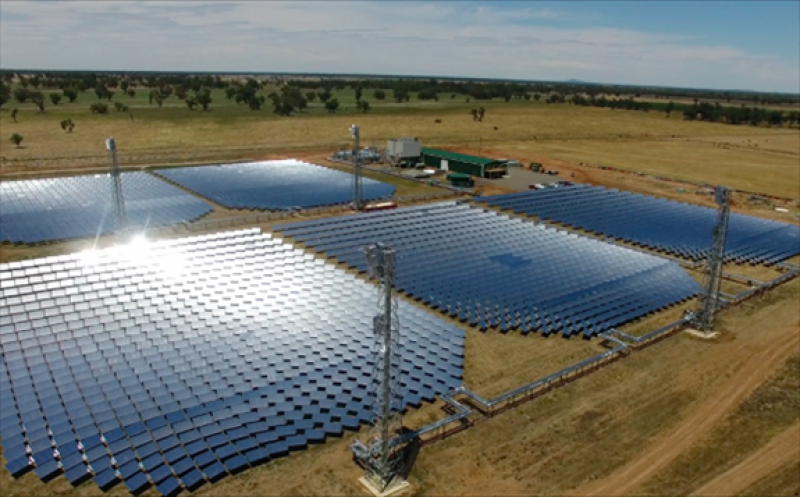Regardless of a tendency to tower over sandy barren plains, forms of generation that rely on storing the sun’s heat focused by a field of mirrors have been slow to prove themselves.

The biggest disappointment was the failure of SolarReserve to attract backing for its 165MW Aurora facility in South Australia. The biggest success, meanwhile, has been the system installed at Sundrop Farms in South Australia, which can generate up to 39MW and helps its owner turn out endless shiny truss tomatoes.
The technology suits dry, hot locations, which is part of the reason why Australian concentrated solar thermal power company Vast Solar has attracted financial backing from Queensland government-owned Stanwell Energy to look into the feasibility for a 50MW solar thermal plant in Mount Isa, north-west Queensland.
“Once you get the technology right, it will be the cheapest form of dispatchable renewable energy in hot dry places,” says Vast Solar CEO Craig Wood. “We’re quite confident in that.”
The $600 million plant would supply Mount Isa and the North West Minerals Province, which is not connected to the National Electricity Market.
Vast is offering a modular solution where fields of heliostat mirrors focus the sun onto collecting towers. The heat is captured in liquid sodium metal and then transferred to salt, where it is stored to use to create steam to then drive a turbine to free electrons into the grid.
“We have dispatchable renewable energy because that storage means that we can hold the energy in the salt until such time as the electricity is needed,” Wood tells EcoGeneration.
The salt reserves typically stay above 550°C, whereas the sodium heated by the focused sunlight reaches about 580°C.
Up above
Vast started work on a pilot plant in 2014 that was connected to the grid in 2018, where each tower collects heat from 700 heliostats. At Mount Isa Wood anticipates more than 2,000 heliostats will be directed at each tower, with 30 towers planned for. “The system is getting larger, each of the modules is getting bigger, but the concept remains the same.”
The heliostats are each fitted with a drive mechanism so they can focus the sun’s rays onto the receiving tower from sun-up to sundown.
The solar-thermal plant will provide night-time energy, alloyed to PV and a battery for daytime. A bank of gas engines stands in reserve for those times when the solar output is affected by lousy weather or the thermal storage is depleted in the morning.
“The secret is there are four assets that are dispatched as part of a system to deliver 50MW of flat supply to run mines in the Mount Isa region,” Wood says.
Vast Solar is a developer and part-owner of the project with Stanwell, and “importantly” it will be supplying equipment, Wood says. The heliostats will be assembled at a facility on the site. “We have developed supply chains with various specialist partners all over the world,” he says. “Heliostats are relatively fragile once they’re fully assembled, so you don’t want to be shipping assembled heliostats around the world.”
A 50MW project is “smaller than you would ideally like” to make the Vast technology deliver energy at a competitive cost, Wood says. “The way CSP works is it’s really once turbines get to 100MW that the energy starts being very cheap.” Nevertheless, he is confident Vast will be able to deliver against the $100/MWh target identified in the federal government’s Low-emissions Technology Statement.
“Our internal target has always been $US50/MWh. We believe you’ve got to be that cheap to be built at scale and form a meaningful part of the transition we have to go through,” he says.
On track
The pilot project has shown Vast Solar to be “a global leader” in the use of liquid sodium in CSP, Wood says. “We got some stuff wrong at the pilot plant, there’s no question,” but overall it has been measured to be a success when assessed on sourcing components, testing designs and establishing supply chains.
The International Energy Agency and International Renewable Energy Agency have both said the fundamentals point to a need for CSP in some form, for it to be developed and deployed widely in hot, dry markets.
Mount Isa is a textbook case study for subsequent plants, he reckons. It makes sense anywhere where there is good solar resource, a large electrical load, an ore body that allows for longevity and confidence for long-term capital for a renewable project, and where energy is currently fossil-based and pumped a long way. Those four things are perfect ingredients for a Mount Isa-style project as “absolutely the cheapest way to run that asset”.
Mine operators in The Pilbara, Olympic Dam, around the rest of Mount Isa and in the Atacama Desert, in South America, might want to keep an eye on this project.
Conceptual talks were kicked off with Stanwell about 18 months ago, Wood says, which evolved into a detailed pre-feasibility study throughout 2020.
Construction is expected to start near the middle of 2022. Stanwell, which owns coal plant in Queensland, and Vast are splitting the $10 million bill for the study.